BIPX4: Community Engagement Support for Northside Volunteers Report
VerifiedAdded on 2020/05/04
|8
|2561
|102
Report
AI Summary
This report analyzes Northside's community engagement strategies, focusing on volunteerism and the DARTS Program. It explores the importance of volunteers in supporting the elderly, highlighting the need for effective volunteer management and cultural sensitivity. The report discusses the benefits of volunteerism, including improved health and socio-emotional control for the elderly. It also examines organizational sustainability through capacity building, coalition building, and community engagement strategies. The report emphasizes the importance of volunteer contributions, the need for investment in volunteer programs, and the role of technology in facilitating communication and engagement. Finally, it addresses the challenges of cultural diversity and the importance of recognizing the unique contributions of each volunteer, ensuring that the privileges volunteers enjoy are proportional to their contributions.

BIPX1
Community Engagement Support
Name
Course
Instructor
Date
Community Engagement Support
Name
Course
Instructor
Date
Paraphrase This Document
Need a fresh take? Get an instant paraphrase of this document with our AI Paraphraser
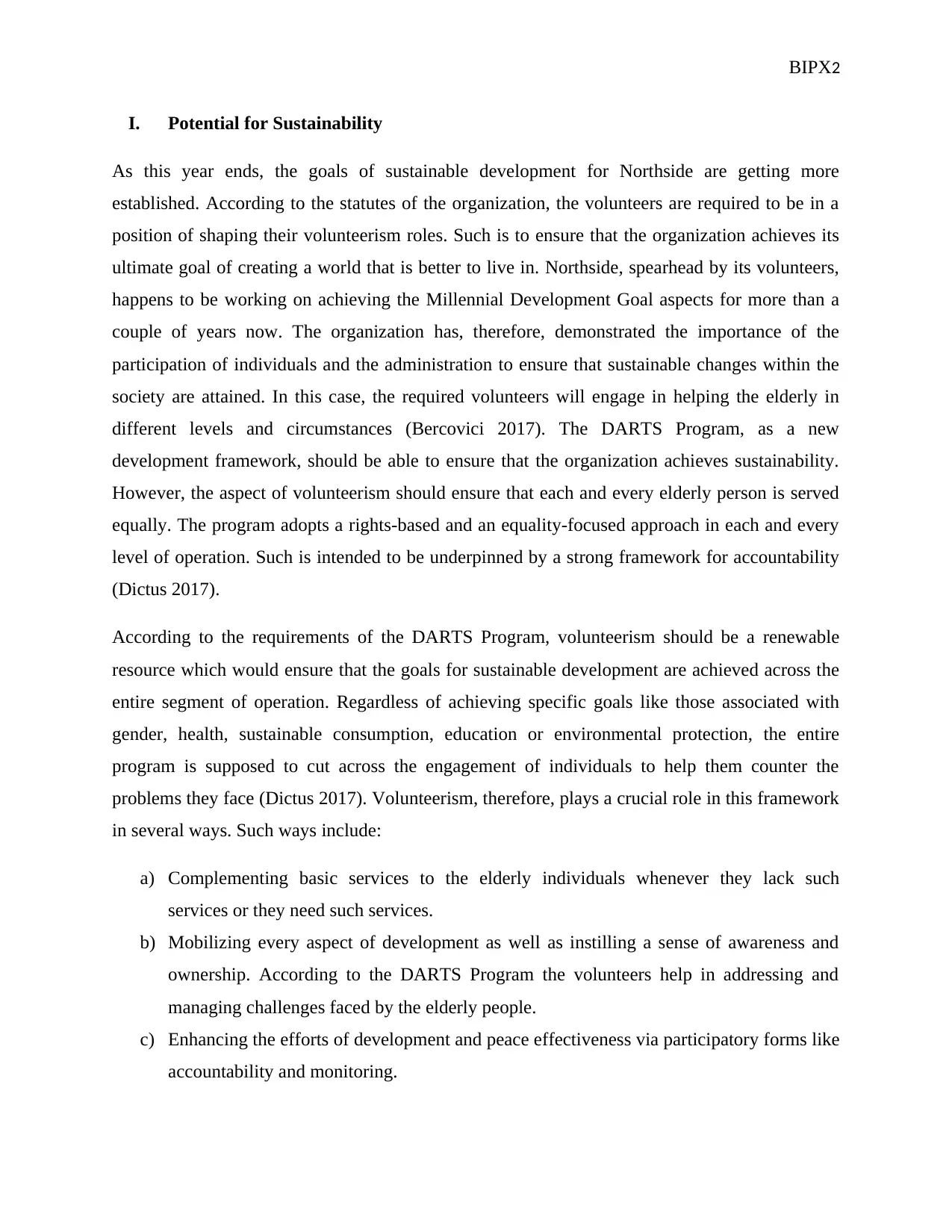
BIPX2
I. Potential for Sustainability
As this year ends, the goals of sustainable development for Northside are getting more
established. According to the statutes of the organization, the volunteers are required to be in a
position of shaping their volunteerism roles. Such is to ensure that the organization achieves its
ultimate goal of creating a world that is better to live in. Northside, spearhead by its volunteers,
happens to be working on achieving the Millennial Development Goal aspects for more than a
couple of years now. The organization has, therefore, demonstrated the importance of the
participation of individuals and the administration to ensure that sustainable changes within the
society are attained. In this case, the required volunteers will engage in helping the elderly in
different levels and circumstances (Bercovici 2017). The DARTS Program, as a new
development framework, should be able to ensure that the organization achieves sustainability.
However, the aspect of volunteerism should ensure that each and every elderly person is served
equally. The program adopts a rights-based and an equality-focused approach in each and every
level of operation. Such is intended to be underpinned by a strong framework for accountability
(Dictus 2017).
According to the requirements of the DARTS Program, volunteerism should be a renewable
resource which would ensure that the goals for sustainable development are achieved across the
entire segment of operation. Regardless of achieving specific goals like those associated with
gender, health, sustainable consumption, education or environmental protection, the entire
program is supposed to cut across the engagement of individuals to help them counter the
problems they face (Dictus 2017). Volunteerism, therefore, plays a crucial role in this framework
in several ways. Such ways include:
a) Complementing basic services to the elderly individuals whenever they lack such
services or they need such services.
b) Mobilizing every aspect of development as well as instilling a sense of awareness and
ownership. According to the DARTS Program the volunteers help in addressing and
managing challenges faced by the elderly people.
c) Enhancing the efforts of development and peace effectiveness via participatory forms like
accountability and monitoring.
I. Potential for Sustainability
As this year ends, the goals of sustainable development for Northside are getting more
established. According to the statutes of the organization, the volunteers are required to be in a
position of shaping their volunteerism roles. Such is to ensure that the organization achieves its
ultimate goal of creating a world that is better to live in. Northside, spearhead by its volunteers,
happens to be working on achieving the Millennial Development Goal aspects for more than a
couple of years now. The organization has, therefore, demonstrated the importance of the
participation of individuals and the administration to ensure that sustainable changes within the
society are attained. In this case, the required volunteers will engage in helping the elderly in
different levels and circumstances (Bercovici 2017). The DARTS Program, as a new
development framework, should be able to ensure that the organization achieves sustainability.
However, the aspect of volunteerism should ensure that each and every elderly person is served
equally. The program adopts a rights-based and an equality-focused approach in each and every
level of operation. Such is intended to be underpinned by a strong framework for accountability
(Dictus 2017).
According to the requirements of the DARTS Program, volunteerism should be a renewable
resource which would ensure that the goals for sustainable development are achieved across the
entire segment of operation. Regardless of achieving specific goals like those associated with
gender, health, sustainable consumption, education or environmental protection, the entire
program is supposed to cut across the engagement of individuals to help them counter the
problems they face (Dictus 2017). Volunteerism, therefore, plays a crucial role in this framework
in several ways. Such ways include:
a) Complementing basic services to the elderly individuals whenever they lack such
services or they need such services.
b) Mobilizing every aspect of development as well as instilling a sense of awareness and
ownership. According to the DARTS Program the volunteers help in addressing and
managing challenges faced by the elderly people.
c) Enhancing the efforts of development and peace effectiveness via participatory forms like
accountability and monitoring.
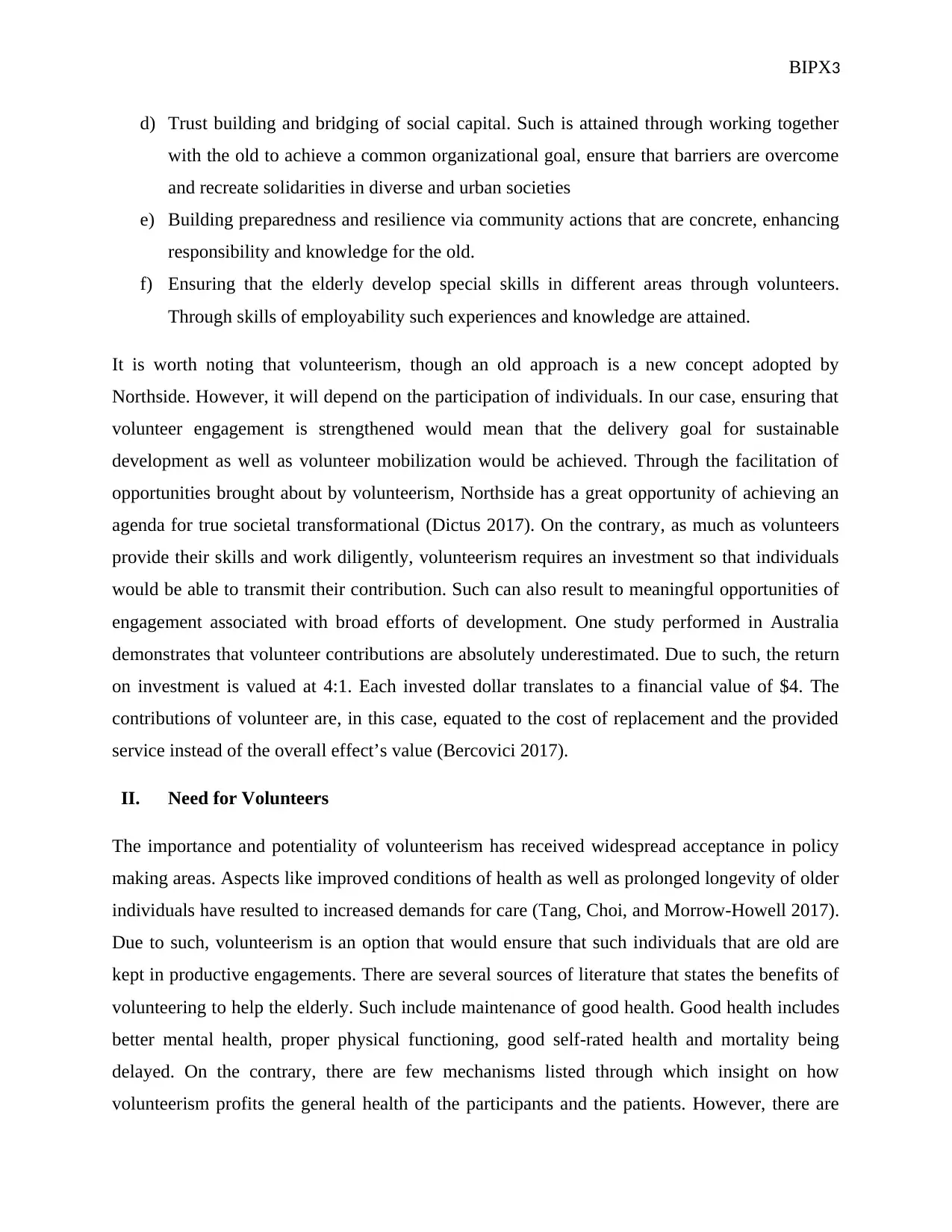
BIPX3
d) Trust building and bridging of social capital. Such is attained through working together
with the old to achieve a common organizational goal, ensure that barriers are overcome
and recreate solidarities in diverse and urban societies
e) Building preparedness and resilience via community actions that are concrete, enhancing
responsibility and knowledge for the old.
f) Ensuring that the elderly develop special skills in different areas through volunteers.
Through skills of employability such experiences and knowledge are attained.
It is worth noting that volunteerism, though an old approach is a new concept adopted by
Northside. However, it will depend on the participation of individuals. In our case, ensuring that
volunteer engagement is strengthened would mean that the delivery goal for sustainable
development as well as volunteer mobilization would be achieved. Through the facilitation of
opportunities brought about by volunteerism, Northside has a great opportunity of achieving an
agenda for true societal transformational (Dictus 2017). On the contrary, as much as volunteers
provide their skills and work diligently, volunteerism requires an investment so that individuals
would be able to transmit their contribution. Such can also result to meaningful opportunities of
engagement associated with broad efforts of development. One study performed in Australia
demonstrates that volunteer contributions are absolutely underestimated. Due to such, the return
on investment is valued at 4:1. Each invested dollar translates to a financial value of $4. The
contributions of volunteer are, in this case, equated to the cost of replacement and the provided
service instead of the overall effect’s value (Bercovici 2017).
II. Need for Volunteers
The importance and potentiality of volunteerism has received widespread acceptance in policy
making areas. Aspects like improved conditions of health as well as prolonged longevity of older
individuals have resulted to increased demands for care (Tang, Choi, and Morrow-Howell 2017).
Due to such, volunteerism is an option that would ensure that such individuals that are old are
kept in productive engagements. There are several sources of literature that states the benefits of
volunteering to help the elderly. Such include maintenance of good health. Good health includes
better mental health, proper physical functioning, good self-rated health and mortality being
delayed. On the contrary, there are few mechanisms listed through which insight on how
volunteerism profits the general health of the participants and the patients. However, there are
d) Trust building and bridging of social capital. Such is attained through working together
with the old to achieve a common organizational goal, ensure that barriers are overcome
and recreate solidarities in diverse and urban societies
e) Building preparedness and resilience via community actions that are concrete, enhancing
responsibility and knowledge for the old.
f) Ensuring that the elderly develop special skills in different areas through volunteers.
Through skills of employability such experiences and knowledge are attained.
It is worth noting that volunteerism, though an old approach is a new concept adopted by
Northside. However, it will depend on the participation of individuals. In our case, ensuring that
volunteer engagement is strengthened would mean that the delivery goal for sustainable
development as well as volunteer mobilization would be achieved. Through the facilitation of
opportunities brought about by volunteerism, Northside has a great opportunity of achieving an
agenda for true societal transformational (Dictus 2017). On the contrary, as much as volunteers
provide their skills and work diligently, volunteerism requires an investment so that individuals
would be able to transmit their contribution. Such can also result to meaningful opportunities of
engagement associated with broad efforts of development. One study performed in Australia
demonstrates that volunteer contributions are absolutely underestimated. Due to such, the return
on investment is valued at 4:1. Each invested dollar translates to a financial value of $4. The
contributions of volunteer are, in this case, equated to the cost of replacement and the provided
service instead of the overall effect’s value (Bercovici 2017).
II. Need for Volunteers
The importance and potentiality of volunteerism has received widespread acceptance in policy
making areas. Aspects like improved conditions of health as well as prolonged longevity of older
individuals have resulted to increased demands for care (Tang, Choi, and Morrow-Howell 2017).
Due to such, volunteerism is an option that would ensure that such individuals that are old are
kept in productive engagements. There are several sources of literature that states the benefits of
volunteering to help the elderly. Such include maintenance of good health. Good health includes
better mental health, proper physical functioning, good self-rated health and mortality being
delayed. On the contrary, there are few mechanisms listed through which insight on how
volunteerism profits the general health of the participants and the patients. However, there are
⊘ This is a preview!⊘
Do you want full access?
Subscribe today to unlock all pages.

Trusted by 1+ million students worldwide
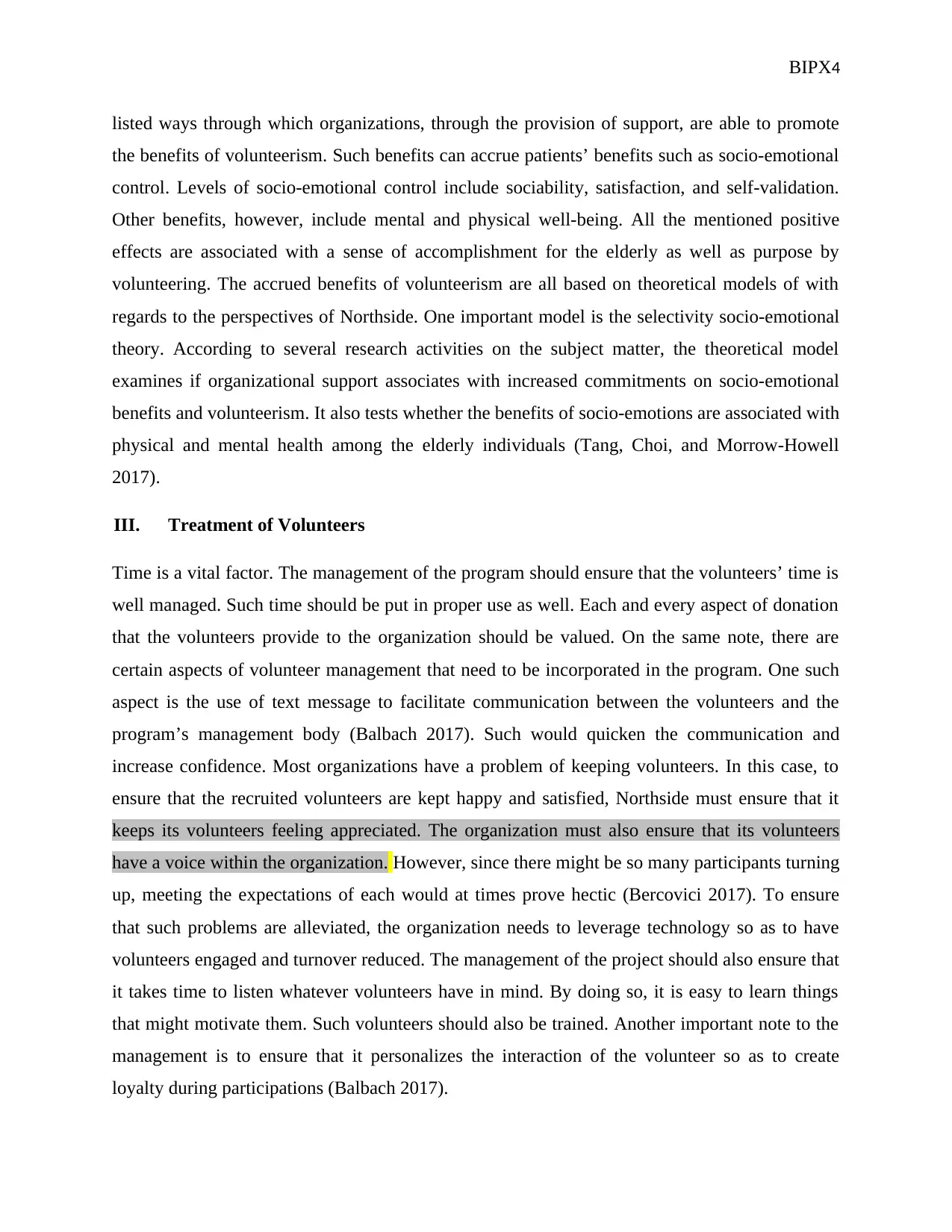
BIPX4
listed ways through which organizations, through the provision of support, are able to promote
the benefits of volunteerism. Such benefits can accrue patients’ benefits such as socio-emotional
control. Levels of socio-emotional control include sociability, satisfaction, and self-validation.
Other benefits, however, include mental and physical well-being. All the mentioned positive
effects are associated with a sense of accomplishment for the elderly as well as purpose by
volunteering. The accrued benefits of volunteerism are all based on theoretical models of with
regards to the perspectives of Northside. One important model is the selectivity socio-emotional
theory. According to several research activities on the subject matter, the theoretical model
examines if organizational support associates with increased commitments on socio-emotional
benefits and volunteerism. It also tests whether the benefits of socio-emotions are associated with
physical and mental health among the elderly individuals (Tang, Choi, and Morrow-Howell
2017).
III. Treatment of Volunteers
Time is a vital factor. The management of the program should ensure that the volunteers’ time is
well managed. Such time should be put in proper use as well. Each and every aspect of donation
that the volunteers provide to the organization should be valued. On the same note, there are
certain aspects of volunteer management that need to be incorporated in the program. One such
aspect is the use of text message to facilitate communication between the volunteers and the
program’s management body (Balbach 2017). Such would quicken the communication and
increase confidence. Most organizations have a problem of keeping volunteers. In this case, to
ensure that the recruited volunteers are kept happy and satisfied, Northside must ensure that it
keeps its volunteers feeling appreciated. The organization must also ensure that its volunteers
have a voice within the organization. However, since there might be so many participants turning
up, meeting the expectations of each would at times prove hectic (Bercovici 2017). To ensure
that such problems are alleviated, the organization needs to leverage technology so as to have
volunteers engaged and turnover reduced. The management of the project should also ensure that
it takes time to listen whatever volunteers have in mind. By doing so, it is easy to learn things
that might motivate them. Such volunteers should also be trained. Another important note to the
management is to ensure that it personalizes the interaction of the volunteer so as to create
loyalty during participations (Balbach 2017).
listed ways through which organizations, through the provision of support, are able to promote
the benefits of volunteerism. Such benefits can accrue patients’ benefits such as socio-emotional
control. Levels of socio-emotional control include sociability, satisfaction, and self-validation.
Other benefits, however, include mental and physical well-being. All the mentioned positive
effects are associated with a sense of accomplishment for the elderly as well as purpose by
volunteering. The accrued benefits of volunteerism are all based on theoretical models of with
regards to the perspectives of Northside. One important model is the selectivity socio-emotional
theory. According to several research activities on the subject matter, the theoretical model
examines if organizational support associates with increased commitments on socio-emotional
benefits and volunteerism. It also tests whether the benefits of socio-emotions are associated with
physical and mental health among the elderly individuals (Tang, Choi, and Morrow-Howell
2017).
III. Treatment of Volunteers
Time is a vital factor. The management of the program should ensure that the volunteers’ time is
well managed. Such time should be put in proper use as well. Each and every aspect of donation
that the volunteers provide to the organization should be valued. On the same note, there are
certain aspects of volunteer management that need to be incorporated in the program. One such
aspect is the use of text message to facilitate communication between the volunteers and the
program’s management body (Balbach 2017). Such would quicken the communication and
increase confidence. Most organizations have a problem of keeping volunteers. In this case, to
ensure that the recruited volunteers are kept happy and satisfied, Northside must ensure that it
keeps its volunteers feeling appreciated. The organization must also ensure that its volunteers
have a voice within the organization. However, since there might be so many participants turning
up, meeting the expectations of each would at times prove hectic (Bercovici 2017). To ensure
that such problems are alleviated, the organization needs to leverage technology so as to have
volunteers engaged and turnover reduced. The management of the project should also ensure that
it takes time to listen whatever volunteers have in mind. By doing so, it is easy to learn things
that might motivate them. Such volunteers should also be trained. Another important note to the
management is to ensure that it personalizes the interaction of the volunteer so as to create
loyalty during participations (Balbach 2017).
Paraphrase This Document
Need a fresh take? Get an instant paraphrase of this document with our AI Paraphraser
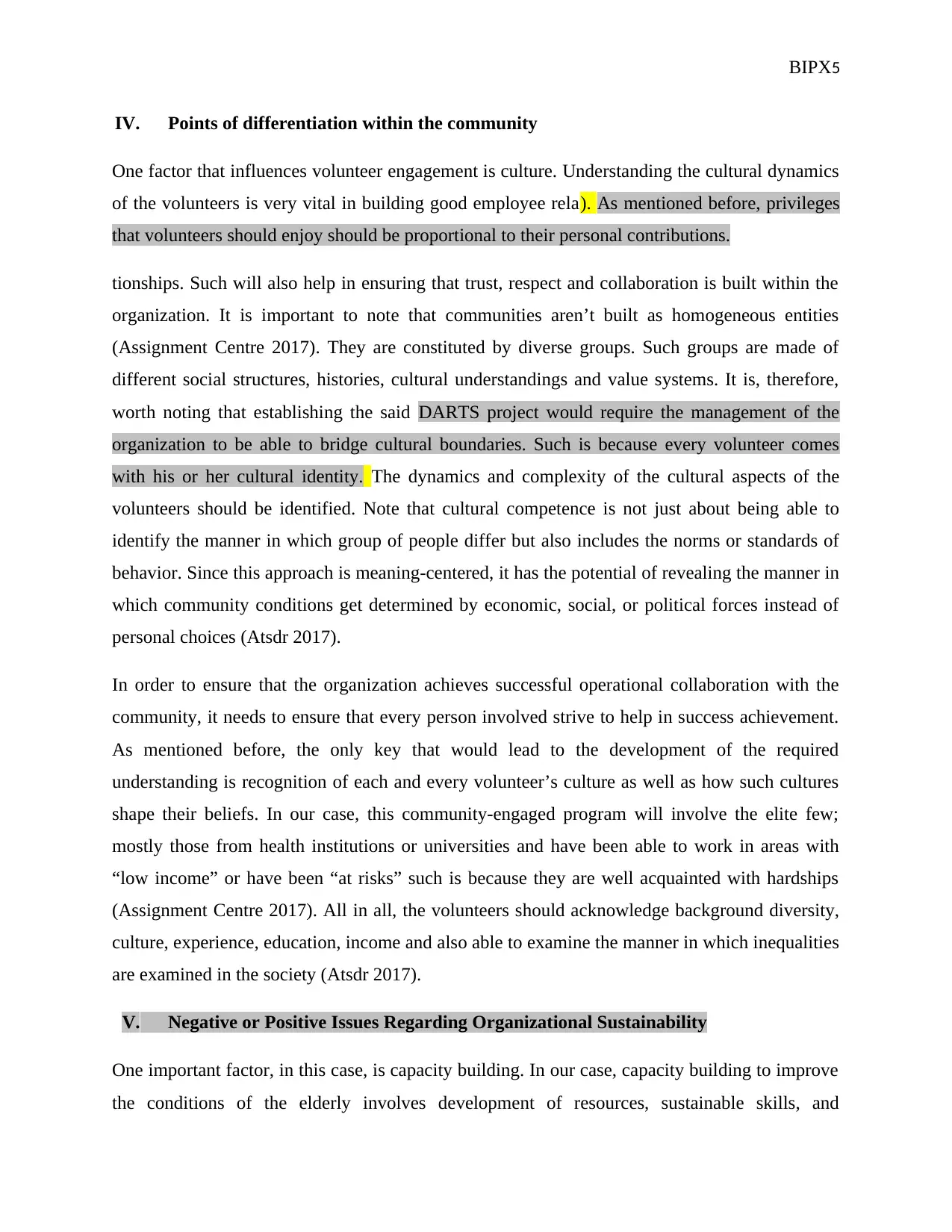
BIPX5
IV. Points of differentiation within the community
One factor that influences volunteer engagement is culture. Understanding the cultural dynamics
of the volunteers is very vital in building good employee rela). As mentioned before, privileges
that volunteers should enjoy should be proportional to their personal contributions.
tionships. Such will also help in ensuring that trust, respect and collaboration is built within the
organization. It is important to note that communities aren’t built as homogeneous entities
(Assignment Centre 2017). They are constituted by diverse groups. Such groups are made of
different social structures, histories, cultural understandings and value systems. It is, therefore,
worth noting that establishing the said DARTS project would require the management of the
organization to be able to bridge cultural boundaries. Such is because every volunteer comes
with his or her cultural identity. The dynamics and complexity of the cultural aspects of the
volunteers should be identified. Note that cultural competence is not just about being able to
identify the manner in which group of people differ but also includes the norms or standards of
behavior. Since this approach is meaning-centered, it has the potential of revealing the manner in
which community conditions get determined by economic, social, or political forces instead of
personal choices (Atsdr 2017).
In order to ensure that the organization achieves successful operational collaboration with the
community, it needs to ensure that every person involved strive to help in success achievement.
As mentioned before, the only key that would lead to the development of the required
understanding is recognition of each and every volunteer’s culture as well as how such cultures
shape their beliefs. In our case, this community-engaged program will involve the elite few;
mostly those from health institutions or universities and have been able to work in areas with
“low income” or have been “at risks” such is because they are well acquainted with hardships
(Assignment Centre 2017). All in all, the volunteers should acknowledge background diversity,
culture, experience, education, income and also able to examine the manner in which inequalities
are examined in the society (Atsdr 2017).
V. Negative or Positive Issues Regarding Organizational Sustainability
One important factor, in this case, is capacity building. In our case, capacity building to improve
the conditions of the elderly involves development of resources, sustainable skills, and
IV. Points of differentiation within the community
One factor that influences volunteer engagement is culture. Understanding the cultural dynamics
of the volunteers is very vital in building good employee rela). As mentioned before, privileges
that volunteers should enjoy should be proportional to their personal contributions.
tionships. Such will also help in ensuring that trust, respect and collaboration is built within the
organization. It is important to note that communities aren’t built as homogeneous entities
(Assignment Centre 2017). They are constituted by diverse groups. Such groups are made of
different social structures, histories, cultural understandings and value systems. It is, therefore,
worth noting that establishing the said DARTS project would require the management of the
organization to be able to bridge cultural boundaries. Such is because every volunteer comes
with his or her cultural identity. The dynamics and complexity of the cultural aspects of the
volunteers should be identified. Note that cultural competence is not just about being able to
identify the manner in which group of people differ but also includes the norms or standards of
behavior. Since this approach is meaning-centered, it has the potential of revealing the manner in
which community conditions get determined by economic, social, or political forces instead of
personal choices (Atsdr 2017).
In order to ensure that the organization achieves successful operational collaboration with the
community, it needs to ensure that every person involved strive to help in success achievement.
As mentioned before, the only key that would lead to the development of the required
understanding is recognition of each and every volunteer’s culture as well as how such cultures
shape their beliefs. In our case, this community-engaged program will involve the elite few;
mostly those from health institutions or universities and have been able to work in areas with
“low income” or have been “at risks” such is because they are well acquainted with hardships
(Assignment Centre 2017). All in all, the volunteers should acknowledge background diversity,
culture, experience, education, income and also able to examine the manner in which inequalities
are examined in the society (Atsdr 2017).
V. Negative or Positive Issues Regarding Organizational Sustainability
One important factor, in this case, is capacity building. In our case, capacity building to improve
the conditions of the elderly involves development of resources, sustainable skills, and
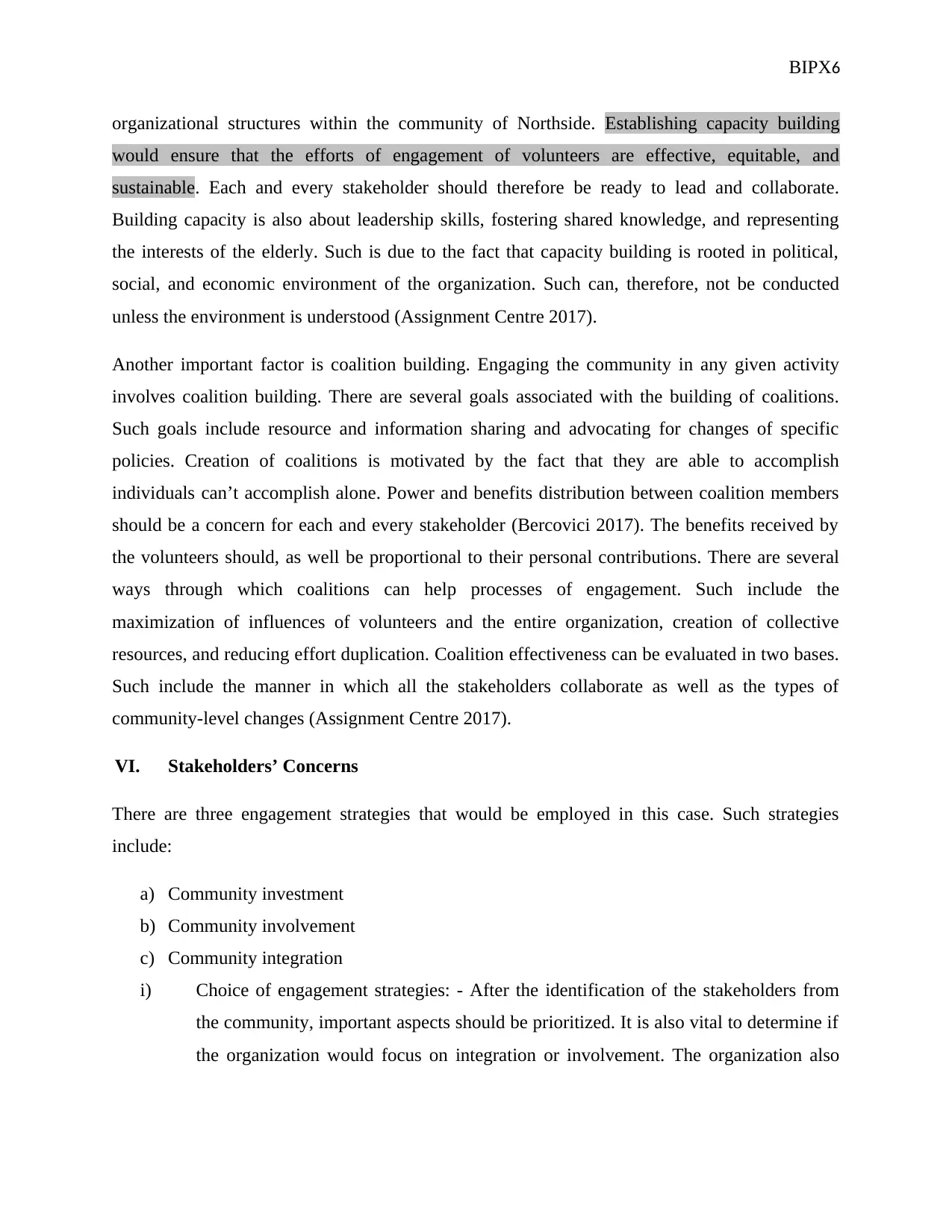
BIPX6
organizational structures within the community of Northside. Establishing capacity building
would ensure that the efforts of engagement of volunteers are effective, equitable, and
sustainable. Each and every stakeholder should therefore be ready to lead and collaborate.
Building capacity is also about leadership skills, fostering shared knowledge, and representing
the interests of the elderly. Such is due to the fact that capacity building is rooted in political,
social, and economic environment of the organization. Such can, therefore, not be conducted
unless the environment is understood (Assignment Centre 2017).
Another important factor is coalition building. Engaging the community in any given activity
involves coalition building. There are several goals associated with the building of coalitions.
Such goals include resource and information sharing and advocating for changes of specific
policies. Creation of coalitions is motivated by the fact that they are able to accomplish
individuals can’t accomplish alone. Power and benefits distribution between coalition members
should be a concern for each and every stakeholder (Bercovici 2017). The benefits received by
the volunteers should, as well be proportional to their personal contributions. There are several
ways through which coalitions can help processes of engagement. Such include the
maximization of influences of volunteers and the entire organization, creation of collective
resources, and reducing effort duplication. Coalition effectiveness can be evaluated in two bases.
Such include the manner in which all the stakeholders collaborate as well as the types of
community-level changes (Assignment Centre 2017).
VI. Stakeholders’ Concerns
There are three engagement strategies that would be employed in this case. Such strategies
include:
a) Community investment
b) Community involvement
c) Community integration
i) Choice of engagement strategies: - After the identification of the stakeholders from
the community, important aspects should be prioritized. It is also vital to determine if
the organization would focus on integration or involvement. The organization also
organizational structures within the community of Northside. Establishing capacity building
would ensure that the efforts of engagement of volunteers are effective, equitable, and
sustainable. Each and every stakeholder should therefore be ready to lead and collaborate.
Building capacity is also about leadership skills, fostering shared knowledge, and representing
the interests of the elderly. Such is due to the fact that capacity building is rooted in political,
social, and economic environment of the organization. Such can, therefore, not be conducted
unless the environment is understood (Assignment Centre 2017).
Another important factor is coalition building. Engaging the community in any given activity
involves coalition building. There are several goals associated with the building of coalitions.
Such goals include resource and information sharing and advocating for changes of specific
policies. Creation of coalitions is motivated by the fact that they are able to accomplish
individuals can’t accomplish alone. Power and benefits distribution between coalition members
should be a concern for each and every stakeholder (Bercovici 2017). The benefits received by
the volunteers should, as well be proportional to their personal contributions. There are several
ways through which coalitions can help processes of engagement. Such include the
maximization of influences of volunteers and the entire organization, creation of collective
resources, and reducing effort duplication. Coalition effectiveness can be evaluated in two bases.
Such include the manner in which all the stakeholders collaborate as well as the types of
community-level changes (Assignment Centre 2017).
VI. Stakeholders’ Concerns
There are three engagement strategies that would be employed in this case. Such strategies
include:
a) Community investment
b) Community involvement
c) Community integration
i) Choice of engagement strategies: - After the identification of the stakeholders from
the community, important aspects should be prioritized. It is also vital to determine if
the organization would focus on integration or involvement. The organization also
⊘ This is a preview!⊘
Do you want full access?
Subscribe today to unlock all pages.

Trusted by 1+ million students worldwide
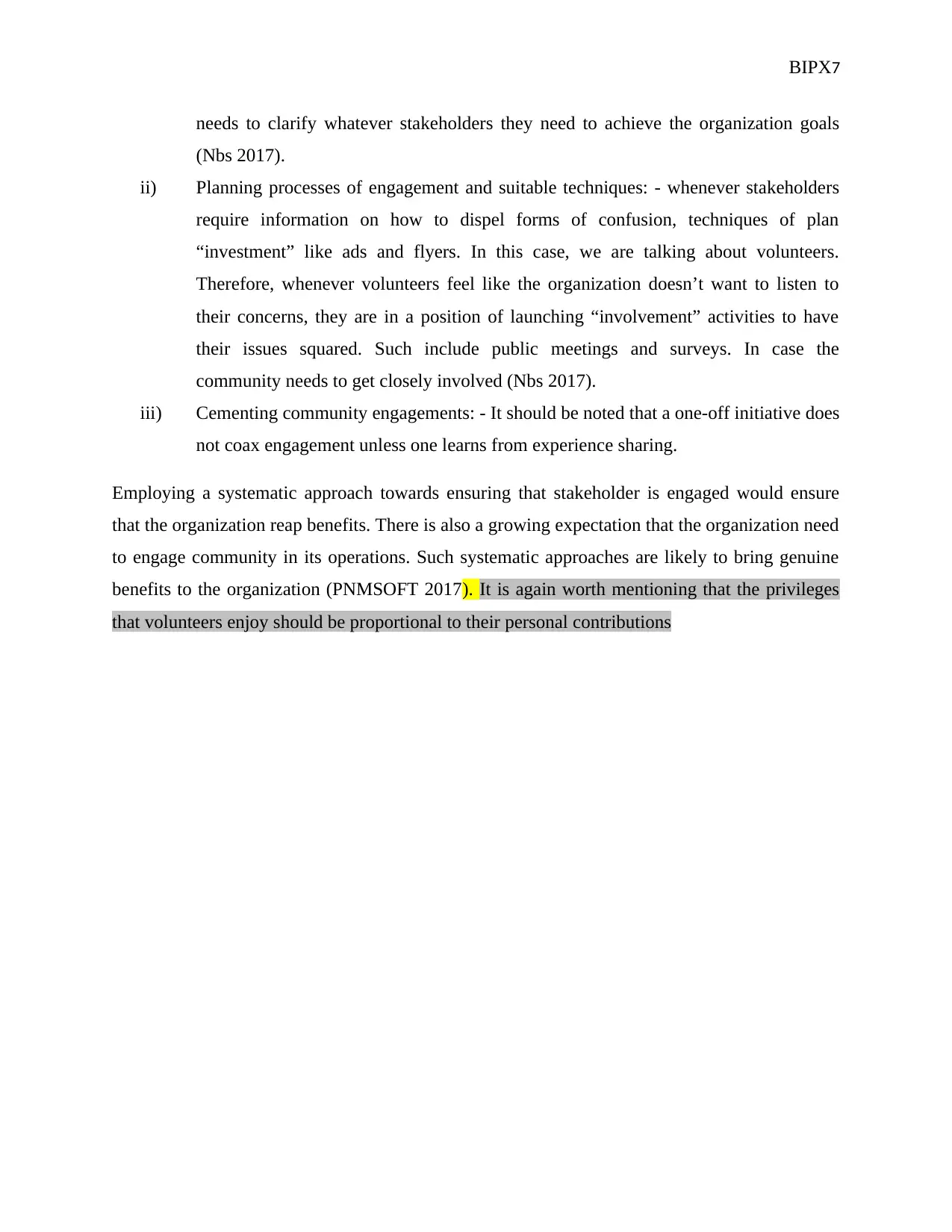
BIPX7
needs to clarify whatever stakeholders they need to achieve the organization goals
(Nbs 2017).
ii) Planning processes of engagement and suitable techniques: - whenever stakeholders
require information on how to dispel forms of confusion, techniques of plan
“investment” like ads and flyers. In this case, we are talking about volunteers.
Therefore, whenever volunteers feel like the organization doesn’t want to listen to
their concerns, they are in a position of launching “involvement” activities to have
their issues squared. Such include public meetings and surveys. In case the
community needs to get closely involved (Nbs 2017).
iii) Cementing community engagements: - It should be noted that a one-off initiative does
not coax engagement unless one learns from experience sharing.
Employing a systematic approach towards ensuring that stakeholder is engaged would ensure
that the organization reap benefits. There is also a growing expectation that the organization need
to engage community in its operations. Such systematic approaches are likely to bring genuine
benefits to the organization (PNMSOFT 2017). It is again worth mentioning that the privileges
that volunteers enjoy should be proportional to their personal contributions
needs to clarify whatever stakeholders they need to achieve the organization goals
(Nbs 2017).
ii) Planning processes of engagement and suitable techniques: - whenever stakeholders
require information on how to dispel forms of confusion, techniques of plan
“investment” like ads and flyers. In this case, we are talking about volunteers.
Therefore, whenever volunteers feel like the organization doesn’t want to listen to
their concerns, they are in a position of launching “involvement” activities to have
their issues squared. Such include public meetings and surveys. In case the
community needs to get closely involved (Nbs 2017).
iii) Cementing community engagements: - It should be noted that a one-off initiative does
not coax engagement unless one learns from experience sharing.
Employing a systematic approach towards ensuring that stakeholder is engaged would ensure
that the organization reap benefits. There is also a growing expectation that the organization need
to engage community in its operations. Such systematic approaches are likely to bring genuine
benefits to the organization (PNMSOFT 2017). It is again worth mentioning that the privileges
that volunteers enjoy should be proportional to their personal contributions
Paraphrase This Document
Need a fresh take? Get an instant paraphrase of this document with our AI Paraphraser
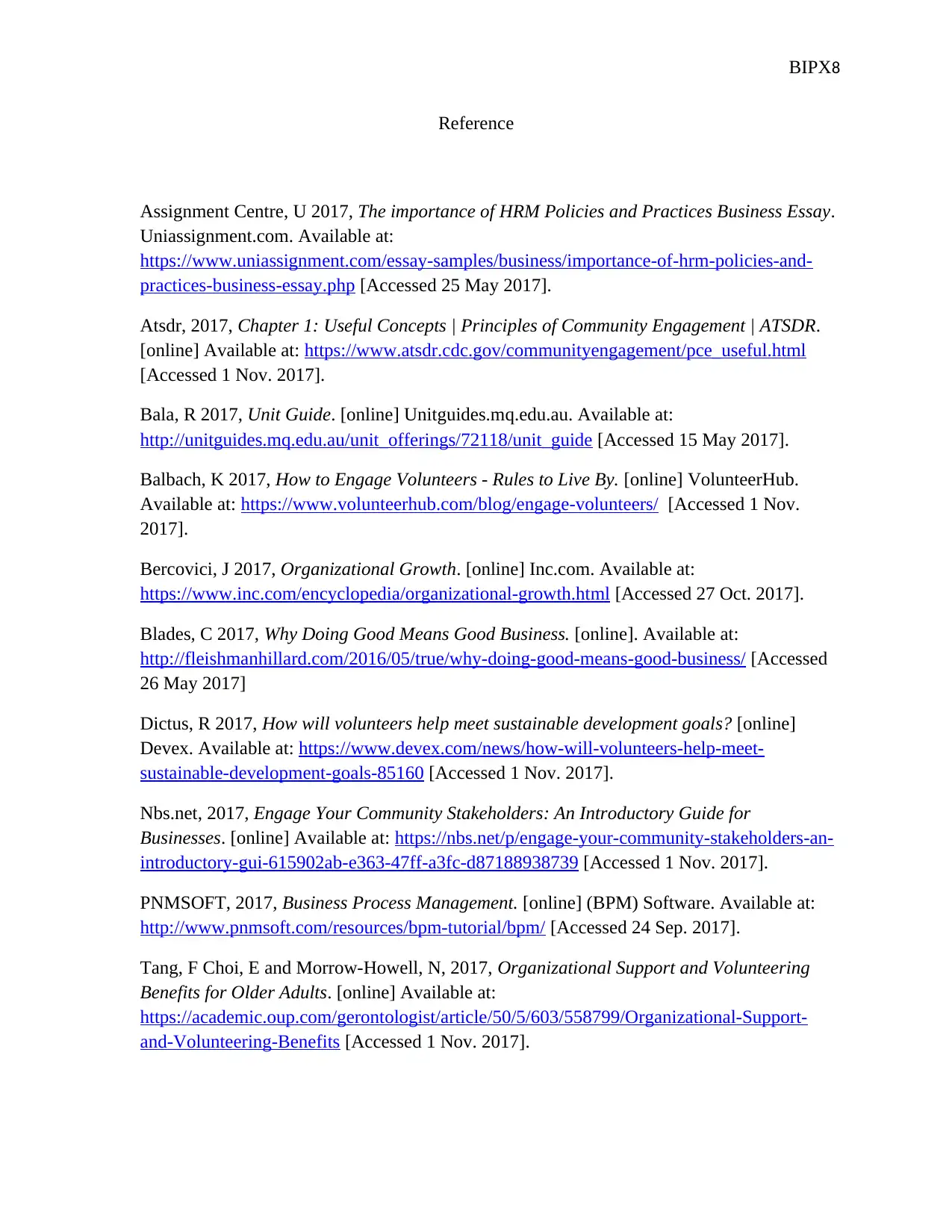
BIPX8
Reference
Assignment Centre, U 2017, The importance of HRM Policies and Practices Business Essay.
Uniassignment.com. Available at:
https://www.uniassignment.com/essay-samples/business/importance-of-hrm-policies-and-
practices-business-essay.php [Accessed 25 May 2017].
Atsdr, 2017, Chapter 1: Useful Concepts | Principles of Community Engagement | ATSDR.
[online] Available at: https://www.atsdr.cdc.gov/communityengagement/pce_useful.html
[Accessed 1 Nov. 2017].
Bala, R 2017, Unit Guide. [online] Unitguides.mq.edu.au. Available at:
http://unitguides.mq.edu.au/unit_offerings/72118/unit_guide [Accessed 15 May 2017].
Balbach, K 2017, How to Engage Volunteers - Rules to Live By. [online] VolunteerHub.
Available at: https://www.volunteerhub.com/blog/engage-volunteers/ [Accessed 1 Nov.
2017].
Bercovici, J 2017, Organizational Growth. [online] Inc.com. Available at:
https://www.inc.com/encyclopedia/organizational-growth.html [Accessed 27 Oct. 2017].
Blades, C 2017, Why Doing Good Means Good Business. [online]. Available at:
http://fleishmanhillard.com/2016/05/true/why-doing-good-means-good-business/ [Accessed
26 May 2017]
Dictus, R 2017, How will volunteers help meet sustainable development goals? [online]
Devex. Available at: https://www.devex.com/news/how-will-volunteers-help-meet-
sustainable-development-goals-85160 [Accessed 1 Nov. 2017].
Nbs.net, 2017, Engage Your Community Stakeholders: An Introductory Guide for
Businesses. [online] Available at: https://nbs.net/p/engage-your-community-stakeholders-an-
introductory-gui-615902ab-e363-47ff-a3fc-d87188938739 [Accessed 1 Nov. 2017].
PNMSOFT, 2017, Business Process Management. [online] (BPM) Software. Available at:
http://www.pnmsoft.com/resources/bpm-tutorial/bpm/ [Accessed 24 Sep. 2017].
Tang, F Choi, E and Morrow-Howell, N, 2017, Organizational Support and Volunteering
Benefits for Older Adults. [online] Available at:
https://academic.oup.com/gerontologist/article/50/5/603/558799/Organizational-Support-
and-Volunteering-Benefits [Accessed 1 Nov. 2017].
Reference
Assignment Centre, U 2017, The importance of HRM Policies and Practices Business Essay.
Uniassignment.com. Available at:
https://www.uniassignment.com/essay-samples/business/importance-of-hrm-policies-and-
practices-business-essay.php [Accessed 25 May 2017].
Atsdr, 2017, Chapter 1: Useful Concepts | Principles of Community Engagement | ATSDR.
[online] Available at: https://www.atsdr.cdc.gov/communityengagement/pce_useful.html
[Accessed 1 Nov. 2017].
Bala, R 2017, Unit Guide. [online] Unitguides.mq.edu.au. Available at:
http://unitguides.mq.edu.au/unit_offerings/72118/unit_guide [Accessed 15 May 2017].
Balbach, K 2017, How to Engage Volunteers - Rules to Live By. [online] VolunteerHub.
Available at: https://www.volunteerhub.com/blog/engage-volunteers/ [Accessed 1 Nov.
2017].
Bercovici, J 2017, Organizational Growth. [online] Inc.com. Available at:
https://www.inc.com/encyclopedia/organizational-growth.html [Accessed 27 Oct. 2017].
Blades, C 2017, Why Doing Good Means Good Business. [online]. Available at:
http://fleishmanhillard.com/2016/05/true/why-doing-good-means-good-business/ [Accessed
26 May 2017]
Dictus, R 2017, How will volunteers help meet sustainable development goals? [online]
Devex. Available at: https://www.devex.com/news/how-will-volunteers-help-meet-
sustainable-development-goals-85160 [Accessed 1 Nov. 2017].
Nbs.net, 2017, Engage Your Community Stakeholders: An Introductory Guide for
Businesses. [online] Available at: https://nbs.net/p/engage-your-community-stakeholders-an-
introductory-gui-615902ab-e363-47ff-a3fc-d87188938739 [Accessed 1 Nov. 2017].
PNMSOFT, 2017, Business Process Management. [online] (BPM) Software. Available at:
http://www.pnmsoft.com/resources/bpm-tutorial/bpm/ [Accessed 24 Sep. 2017].
Tang, F Choi, E and Morrow-Howell, N, 2017, Organizational Support and Volunteering
Benefits for Older Adults. [online] Available at:
https://academic.oup.com/gerontologist/article/50/5/603/558799/Organizational-Support-
and-Volunteering-Benefits [Accessed 1 Nov. 2017].
1 out of 8
Related Documents
Your All-in-One AI-Powered Toolkit for Academic Success.
+13062052269
info@desklib.com
Available 24*7 on WhatsApp / Email
![[object Object]](/_next/static/media/star-bottom.7253800d.svg)
Unlock your academic potential
Copyright © 2020–2025 A2Z Services. All Rights Reserved. Developed and managed by ZUCOL.




